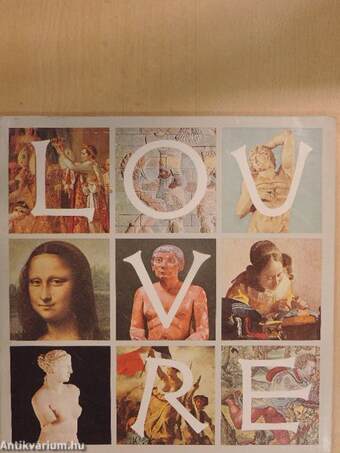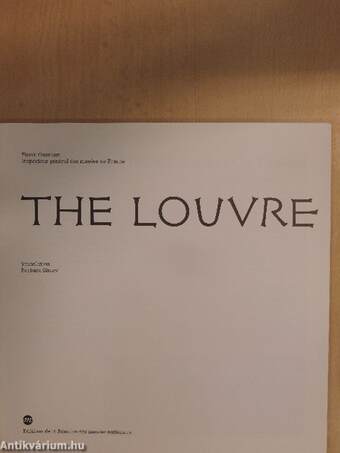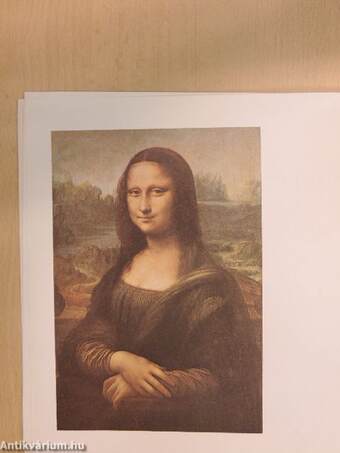1.067.339
kiadvánnyal nyújtjuk Magyarország legnagyobb antikvár könyv-kínálatát

VISSZA
A TETEJÉRE
JAVASLATOKÉszre-
vételek
The Louvre
| Kiadó: | Editions de la Réunion des musées nationaux |
|---|---|
| Kiadás helye: | Párizs |
| Kiadás éve: | |
| Kötés típusa: | Varrott papírkötés |
| Oldalszám: | 95 oldal |
| Sorozatcím: | |
| Kötetszám: | |
| Nyelv: | Angol |
| Méret: | 19 cm x 18 cm |
| ISBN: | 2-71-18-0040-7 |
| Megjegyzés: | Színes és fekete-fehér fotókkal, reprodukciókkal. |
naponta értesítjük a beérkező friss
kiadványokról
naponta értesítjük a beérkező friss
kiadványokról
Előszó
The Palace and the Museum of the Louvre The Louvre was originally a medieval fortress, built in 1200, during Philippe Auguste's reign, on a location at which Paris's defenses were the weakest, a... TovábbElőszó
The Palace and the Museum of the Louvre The Louvre was originally a medieval fortress, built in 1200, during Philippe Auguste's reign, on a location at which Paris's defenses were the weakest, a site called Lupara, which became Louvre in French. This location corresponds to the present site of the southwest quarter of the Square Courtyard. When the structure ceased to serve as a defense post, Charles V (1364-1380) enlarged it and made it into a royal residence. However, its new function soon came to an end: the vicissitudes of the Hundred Years' War, and eventually the attraction of the Loire valley diverted the sovereigns' attention from their capital city for over one and a half centuries. After their return to Paris, the early fortified castle vanished. Francois I had its imposing keep demolished in 1527, and, in 1546, decided to replace the rest by a Renaissance-style building. This undertaking was assigned to the architect Pierre Lescot, who completed it under the last Valois kings and is assumed to have drafted the plans of the new palace. Whatever the case, the work was carried on over the ensuing reigns and centuries in the same spirit of classical regularity. Catherine de' Medici commissioned Philibert Delorme and Jean Bull and to construct two galleries about 500 meters to the west, on a location known as the Tuileries, designed to connect the partially transformed Louvre with the palace built at the same period. These are the Small Gallery and the Great Gallery, the latter alsó being known as the "Riverside Gallery," associated with Henri IV (1589-1610). In the 17th century, under Louis XIII and later Louis XIV, the other buildings surrounding the present Square Courtyard were erected by Lemercier and Le Vau. They are flanked on the east by Perrault's colonnade d). In the early 19th century, under Napoleon I, Percier and Fontaine began the construction of the north wing, symmetrical with the Great Gallery, while alsó completing the quadrilateral buildings and their decoration. Half a century later, Napoleon IH had Visconti and Lefuel construct the buildings bordering the Napoleon courtyard on the north and south, designed to complete the enclosure of the space between the early Louvre and the Tuileries (2). However, the Tuileries palace was burned to the ground in 1871, and the unity of the 1. The Louvre palace: Perrault's colonnade VisszaTémakörök
- Idegennyelv > Idegennyelvű könyvek > Angol > Művészetek > Művészettörténet, általános
- Idegennyelv > Idegennyelvű könyvek > Angol > Művelődéstörténet
- Művelődéstörténet > Intézményei > Múzeumok
- Művészetek > Művészettörténet általános > Múzeumok, képtárak > Külföldi > Európai
- Művészetek > Művészettörténet általános > Idegen nyelv > Angol
- Művészetek > Művészettörténet általános > Kiállítások, aukciók, katalógusok > Külföldi










